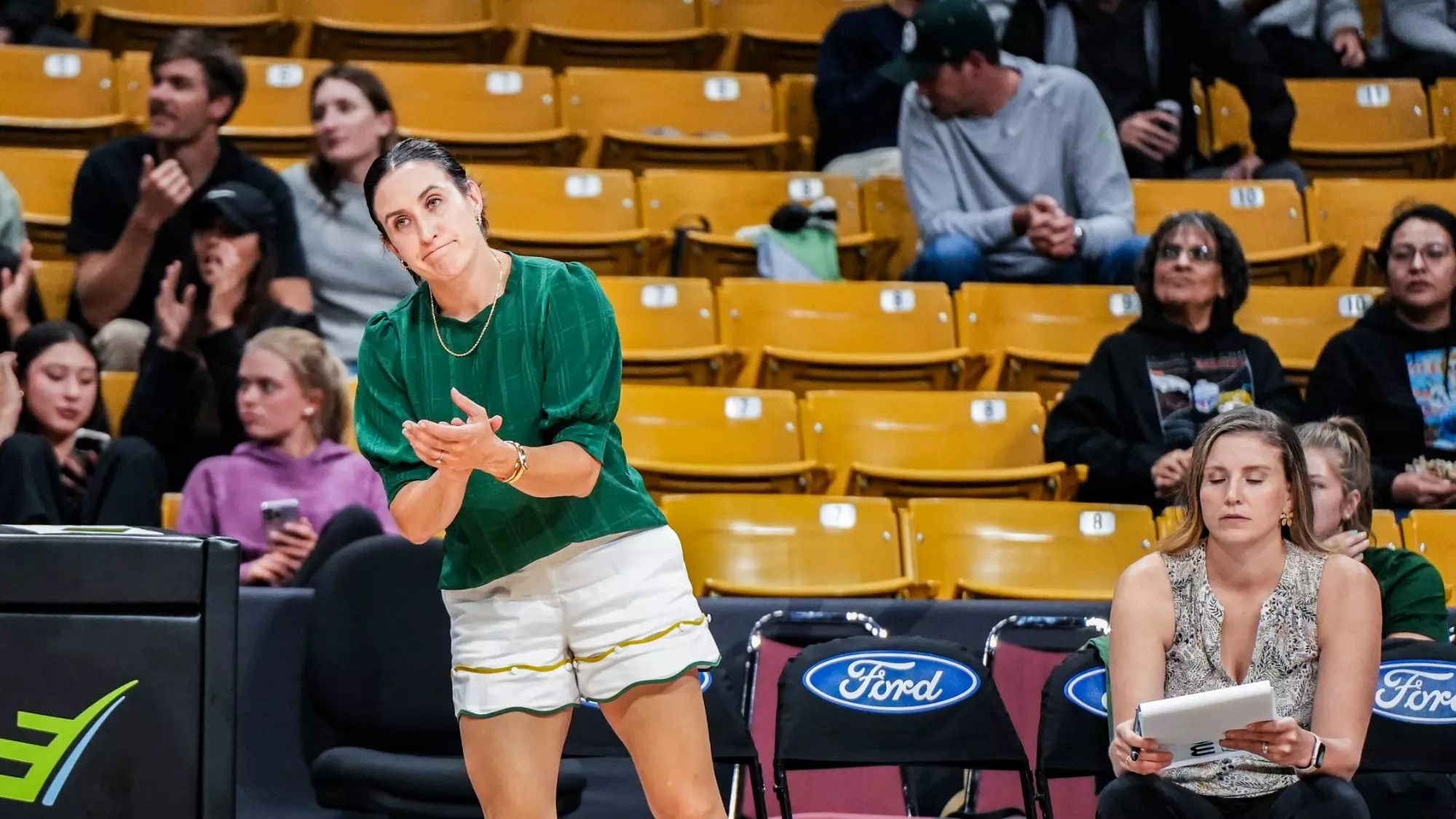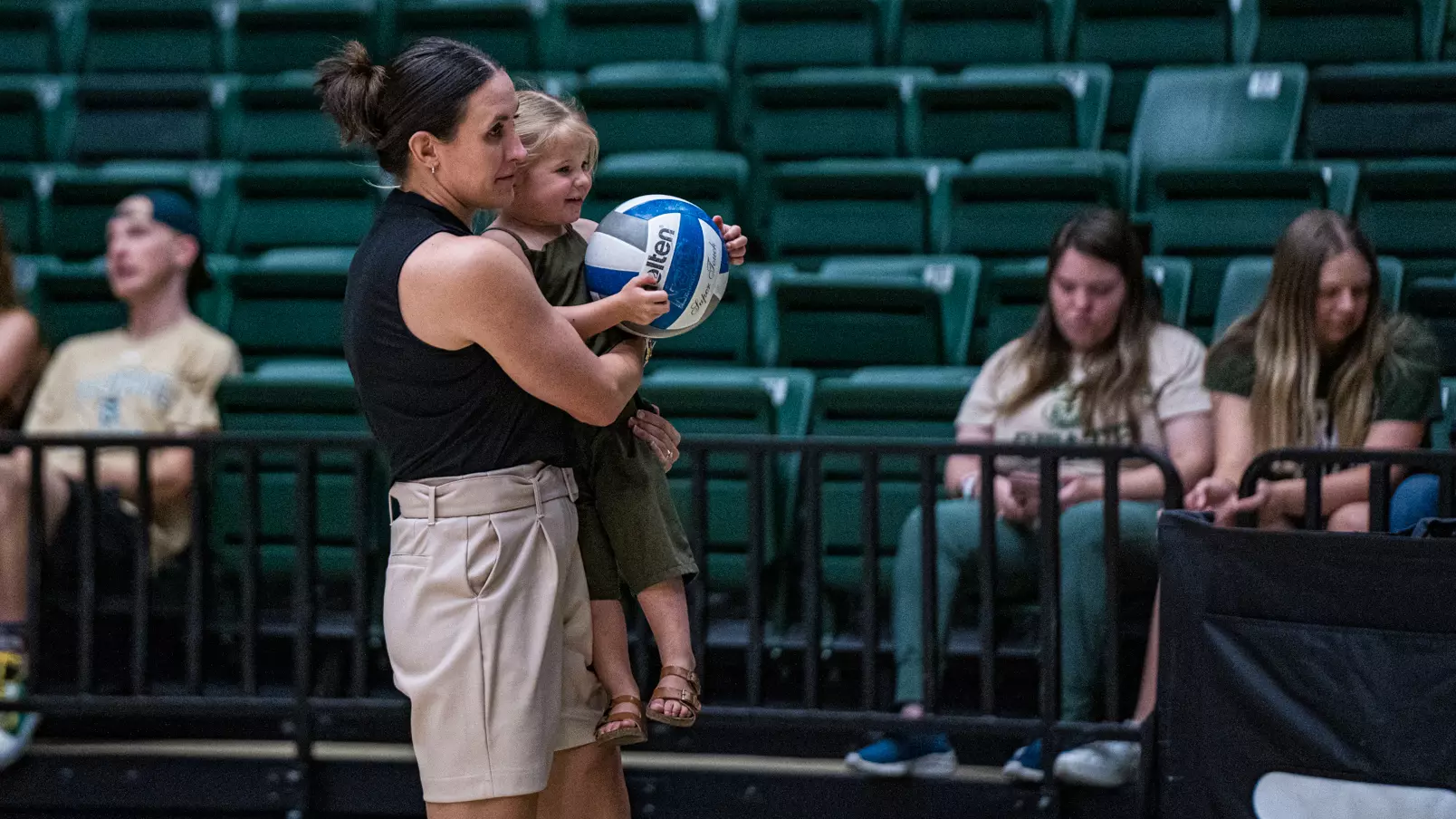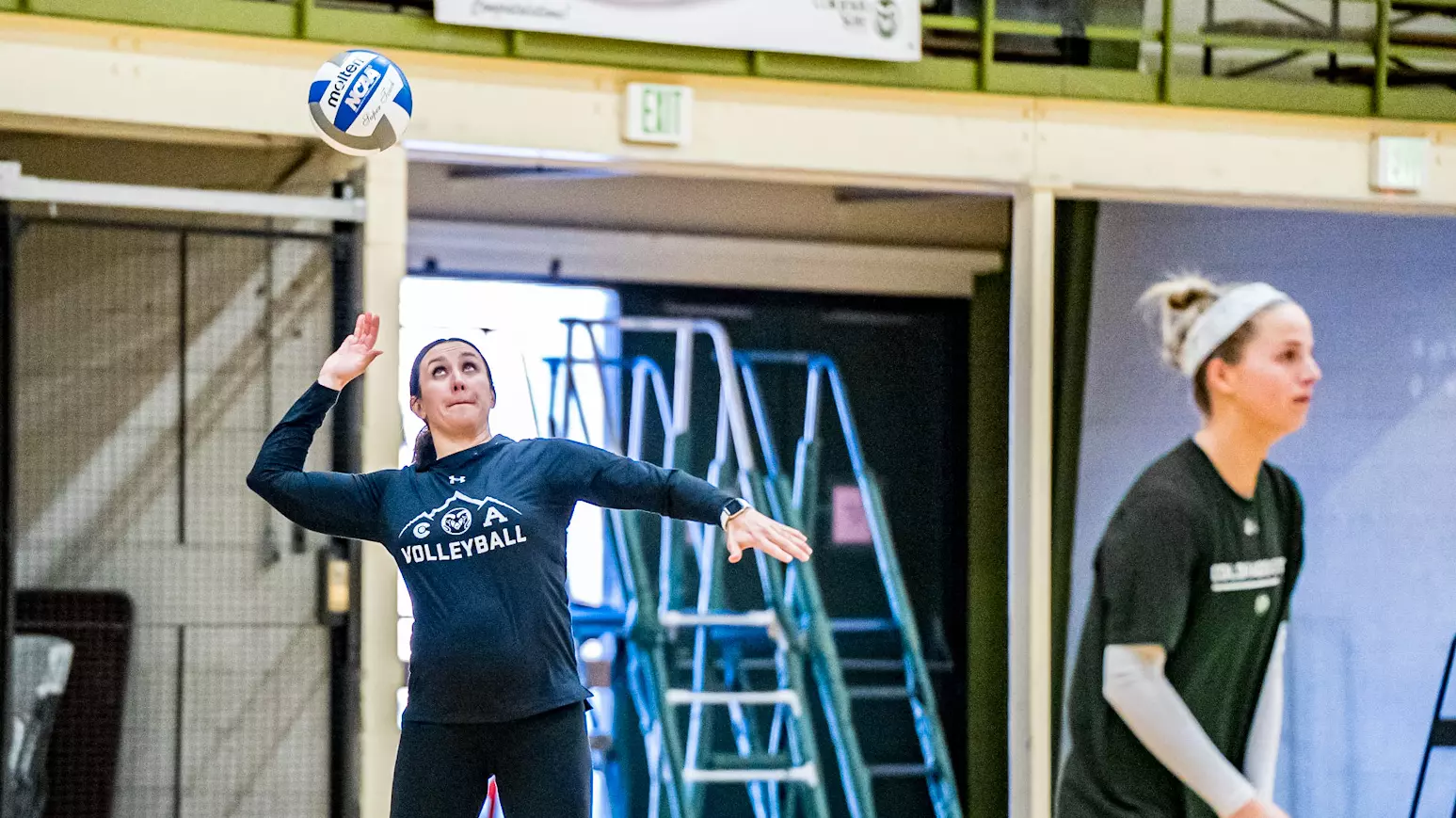
A Search Which May Never End
Kohan still developing her gameday identity
Braidon Nourse
Before this volleyball season, Emily Kohan wasn’t sure what kind of head coach she’d be. She may wonder forever.
Like developing a crushing swing on the outside or a perfect ace-every-time serve, figuring out who you’ll be as a coach is a process. A long process — perhaps one with no end. That’s fine by Kohan, so long as her team is getting better.
“Some of my mentors talk about being way different coaches in year 10 than they are in year one, so maybe you never quite find it,” Kohan said. “But I am enjoying the team and the staff allowing me to have genuine expression in what I’m doing. … Everyone’s been really patient.”
Her first assessment on the job was the season-opener against then No. 10 Kentucky. In front of a record student turnout and a sea of white in the stands, Colorado State got the job done in four sets.
Test passed? With flying colors. Identity found? Not yet.
It was a start, a great one at that. Now, through 13 matches (four against ranked opponents) and seven five-set matches (two against rival Colorado), Kohan isn’t paying too much mind to their 6-7 record.
“We continue to play better and better volleyball each week, which is the question I’m asking myself of ‘are we doing our job as coaches to keep improving them,’” Kohan said. “My answer is yes, and I know we split with Colorado, but we played really good volleyball even in our loss.
“I’m trying not to judge just on the wins and losses but on how good of volleyball we’re playing because we’ve played some really good teams. But I think we’re improving every single week, which tells me it’s an environment where we’re doing our job.”
Over time, Kohan has discovered and enjoyed the freedom involved in taking over the program. Sure, the autonomy comes with a sense of strain, maybe a bit of perplexity with exactly what direction to go, but it can be fun, too.
You just have to go with the flow.
“It’s really fun. It’s stressful and there’s responsibility which comes with you, like (asking) if I know what I’m doing when I try new ideas,” Kohan said. “But I applaud our staff and our girls. They’ve been really open to any kind of new thing we throw out to them. Some of the ideas, it’s like ‘okay, we’re not going to do that again,’ but some of it is really fun. I’m asking the girls to go out and be brave and to try new things and get better at things, and I’m trying to do the same thing as a coach.”
One of the delicate lines Kohan has toed this season is her demeanor on the court. Before game one, she battled internally: am I going to sit or stand during games? Will I yell at refs on the sideline? How am I going to talk to the team during timeouts?
She’s tried a bit of everything — except for yelling at refs, at least for now. There are moments during games when she’ll stand up, clap, celebrate and coach between points. Conversely, there are times you’ll find Kohan sitting alone at the end of the bench, deep in thought.
It’s evolving, still. I think it’s a work in progress and I’m finding authenticity.Emily Kohan
Her temperament with the team varies on game days, too. She tries to balance passion with a certain level of tranquility, whatever the situation requires.
“I think Emily’s done a good job of combining the right level of intensity with the right level of encouragement,” outside hitter Kennedy Stanford said. “She knows when we need a kick in the butt and she knows whenever it’s time to say ‘hey, calm down, smile, I have faith in you.’ She’s developed a good balance of being both a very competitive coach but also a coach who knows how to encourage.
“It’s nice in situations like in our five-setters, just having someone who’s even-keeled and also able to tune into what we need at the time, whether it’s rallying or if it’s to calm us down. That is very helpful in situations where it’s high pressure for all of us.”
Finding that harmony can be difficult for any head coach, let alone a new one. Kohan knows to get to her own goals and those of the team, there needs to be a perfect mix of level-headedness and ferocity. You can’t go out and be both at every moment – each circumstance calls for different attitudes.
According to outside hitter Malaya Jones, Kohan is succeeding in finding her own character while further developing the team’s ability to blossom into something they’ve always wanted to become.
“I think one of the biggest things is she pushes us, and she doesn’t go soft on us,” Jones said. “I think that’s one of the things we really needed. In the past, we’ve been a very timid team and been kind of scared, and I think she knew that, and she needed to push us and our potential to the max. So, I think in finding her identity, she has her softer moments, but I think when it really matters, she’s pushing us and she’s not going easy, and I think that helps us a lot.
“It’s an encouraging push. By no means is it screaming in our faces, but I think it really helps and it brings us back to who we are as people and that’s one of the things she’s really, really good at, just bringing it back to remembering how we play, how we are as a team and connecting.”
Taking over a head coaching job and finding an identity takes a certain level of individuality to be successful, but it also can’t be done alone. Kohan is familiar with the job, drawing from her experience as a head coach for a junior volleyball team, as well as serving as an assistant coach for 10 years between Oregon State and at CSU under Tom Hilbert.
All the familiarity in the world seldom prepares someone for actually stepping into the shoes. There are aspects of the job you prepare for; some can be a gut punch. Big wins take you higher, ugly losses hurt much worse. Hilbert has been there for Kohan in each of those scenarios already.
“I still talk with Tom every week,” Kohan said. “He’s found a good boundary, he doesn’t push his ideas onto me, but he’s always there as a resource if I want to bounce ideas off of him. … He’s a great mentor. After the Kentucky win, my phone blew up with people reaching out to me, but then after we lost to (Northern Colorado), Tom was quite honestly the only person besides my family to text me to say, ‘you okay?’ because he knows the losses are worse than the wins. It just shows how much he cares for the program and for me and he knows what it’s like to go through some of those hard times. He’s still very available.”
Along with all the gameday events, there’s plenty more responsibilities which arise day-to-day as a head coach. She was busy before taking the reins, particularly as a wife and mother of two.
There have been a good deal of sacrifices she has had to make during the transition, particularly her Sundays, which she now dedicates to preparing for the week’s practices and what needs to improve. Because of that, sleep and social activities are a little more limited.
She said the planning, decision-making and communication between her and her assistants are the biggest differences in the daily nature of her work now compared to before. She always gauges the progress made, acknowledging the groove she and her assistants have found themselves in has made it worth the long days.
Kohan also draws on the guidance of old mentors from her days at Oregon State: former head coach Terry Liskevych, who coached the U.S. women’s national volleyball team for 12 years; and former assistant turned head coach Mark Barnard, who spent two years coaching the Australian women’s national volleyball team.
“I respect their leadership style,” Kohan said. “It’s not always the X’s and O’s of volleyball, but advising me on what I’m supposed to do in certain situations. I’m not afraid to go ask good people I respect for feedback and how I can keep getting better.”
But perhaps her biggest helpers are her assistant coaches — Sonja Anderson, Jess Aschenbrenner and Jon Ferrari. While Kohan is the main facilitator of changes on and off the court, she’s received plenty of consultation from her assistants in the team’s scheme and execution.

The growth of players like Jones has been no mistake – the main reason for it has been the shift from being purely an outside force to a six-rotation player, free to roam the floor and attack from the back and even serve at a much higher clip.
“I love it, honestly. I’ve always wanted to play from the back row, but I’ve never been taught how to play defense until I came here,” Jones said. “It’s been really fun to play in the back row, learn how to play defense and make some scrappy plays. Serving is one of my favorite things to do. It’s just been great, and it’s been a whole learning curve.”
It culminated into three straight matches in which Jones recorded at least 20 kills. Before this season, she had never eclipsed that mark.
Injuries played a factor and forced some creativity from Kohan and the coaching staff, but they drew from Ferrari’s and Anderson’s experience from men’s volleyball and international ball, where a lot of offense is initiated from the back row.
“One of our goals was to run a back-row attack in our season more than we have in years past,” Kohan said. “We’ve had a couple injuries which kind of forced Malaya to be a six-rotation player and I think the silver lining of the injuries is she’s finding a groove back there and she’s an offensive weapon out there. She’s getting better at defense back there, too. So maybe it was kind of by accident from the injuries but then we discovered something about her which was like ‘oh shoot, we’ve got to be able to use this.’”
Stanford has also been thrust into the role of playing from the back. Once one of the sole focal points of the offense, she’s also turned into a Swiss Army Knife for the Rams, improving her defense and ultimately having more fun.
Kohan has been a big part of Stanford’s evolution since she arrived on campus in 2020.
“It’s been nice, I mean since my freshman year, she’s been really invested in me developing my game,” Stanford said. “Being able to be here and grow with her has been something I’m blessed to do. It’s nice to see how my game has progressed since then and knowing she’s been basically my primary position coach since I got here. It’s all something I give her a lot of credit for.”
Partly by necessity and partly by design, Kohan has engineered a much more flexible team with many moving parts less than a year into her tenure. Similar to where she is in the search for her own identity as a head coach, her team is figuring out an ability on the court to balance what they do and don’t know.
It’s all part of the process. One from which Jones has taken great satisfaction.
“I think the offense is very fluid and we have a very spread out offense,” Jones said. “I think every single person on this team is amazing and they contribute so much in different moments. I think the way we flow throughout the game, everyone is ready, everyone is talking, and everyone is available, so when it is their turn, we trust them.”
Kohan has taken the time to refresh the culture with new expectations and unique acronyms to compliment the coaching style she’s gradually exploring.
One of the first things she implemented was BUILD, an acronym for the team’s core values which stands for Be a giver, Unity, Inspired work, Leadership and Do your best. A simple formula for a team’s growth if the steps are followed.
She also tried out a captain system, something relatively new to the Rams which so far has worked out. It gives the team another support system and Kohan another stream for ideas, whether it be from coach to captains or captains to coach. This year’s leaders are Stanford, setters Emery Herman and Barrett Power.
“We have captains for really the first time this year and we try to have captains meetings once a week or when we have any kind of issues or things I need discussed amongst the team,” Kohan said. “I think the captains have done a good job and they come up with some great ideas.”
Not everything she or the captains come up with will succeed. Sometimes, they know immediately after trying a new activity or routine they won’t go back to it. But it’s the openness to new ideas which counts for Kohan and through tactical and ideological trial and error, all she wants from her team is the courage to stick out the process.
At this level, not everyone can crack rotations on game day, but everybody plays an important role in preparing for games, especially against more talented teams. Sometimes those players, known around the team as “bomb squad” players, can start to overlook their own value to the team.
As a result, the captains came up with a concept likely to stick: notes of appreciation. Every once in a while, in front of the entire team, the captains will go through one by one to express how each individual is appreciated and how they make the team better.
After all, all anyone is in the business for is to get better. Kohan knows it and has started the search for who she is as a coach with progress as the foundation and as the objective.
“It’s evolving, still. I think it’s a work in progress and I’m finding authenticity,” Kohan said. “I’m finding it’s okay to be intense in situations but hopefully I’m doing it in a way which channels positive play out of it. I wouldn’t say I’ve found her yet, but I’m working on it.”
Each version of Kohan is refined by past experience. There will always be progress, just maybe never a final product.





